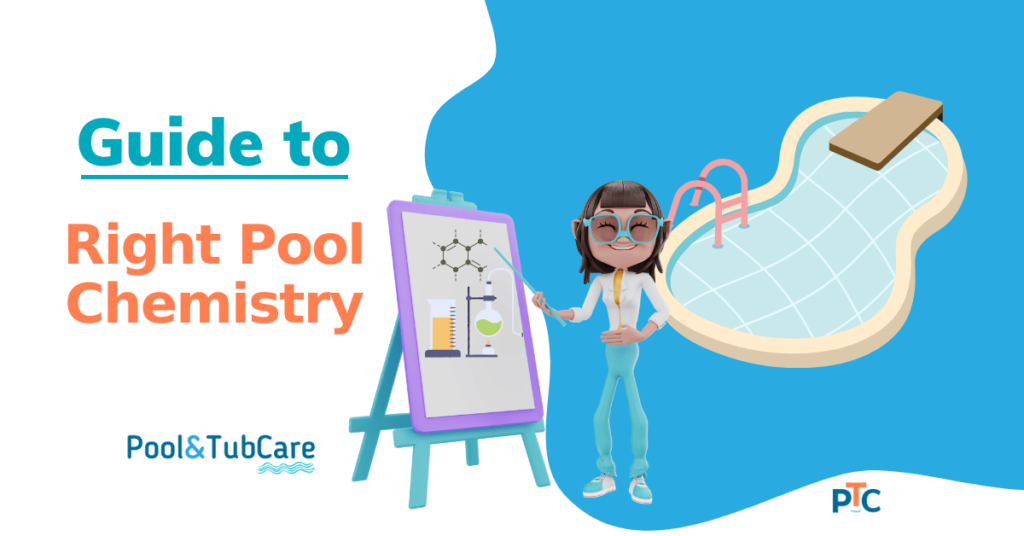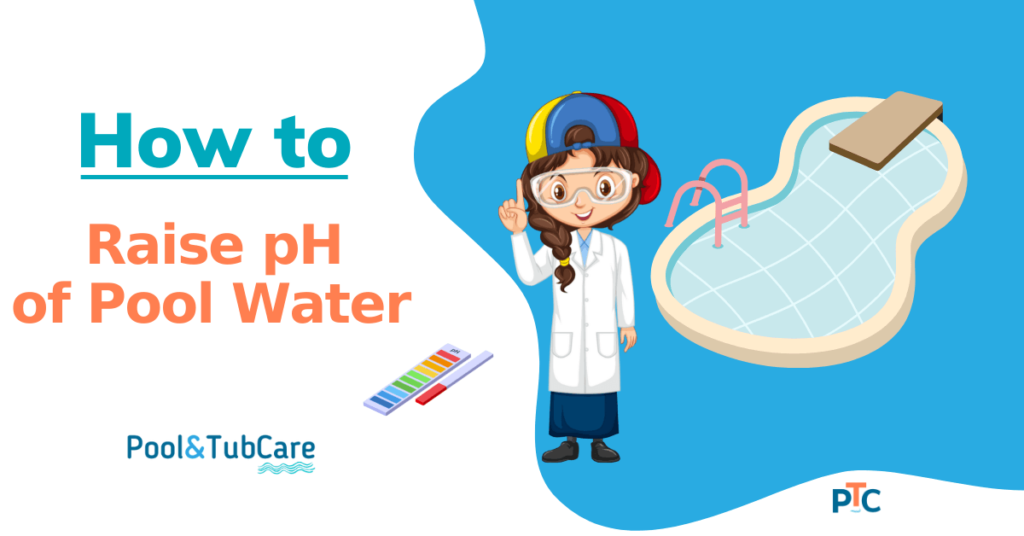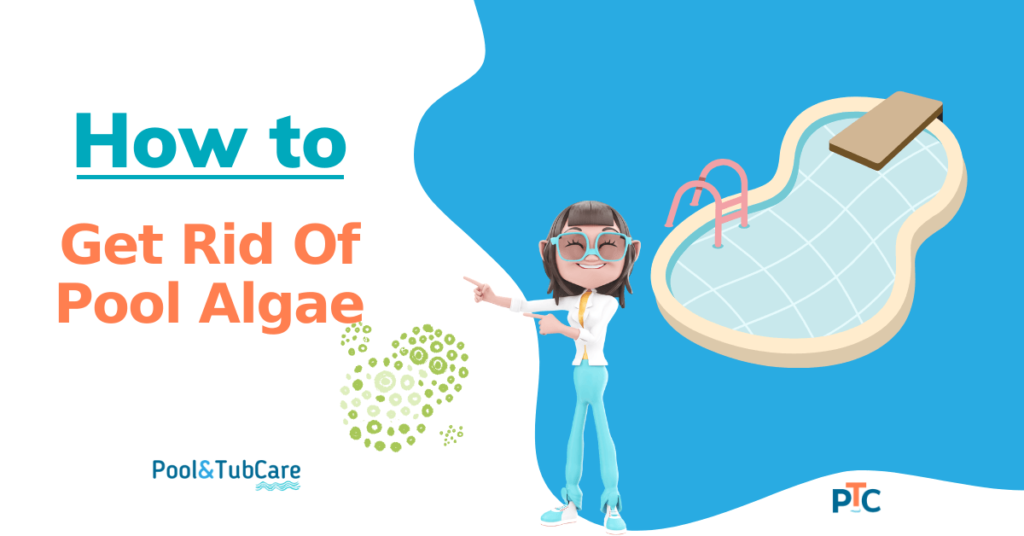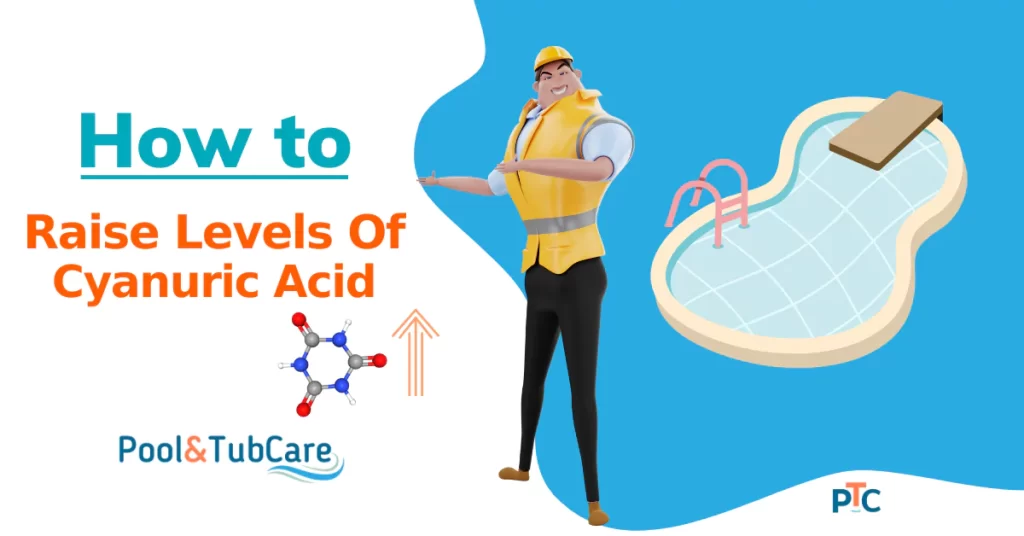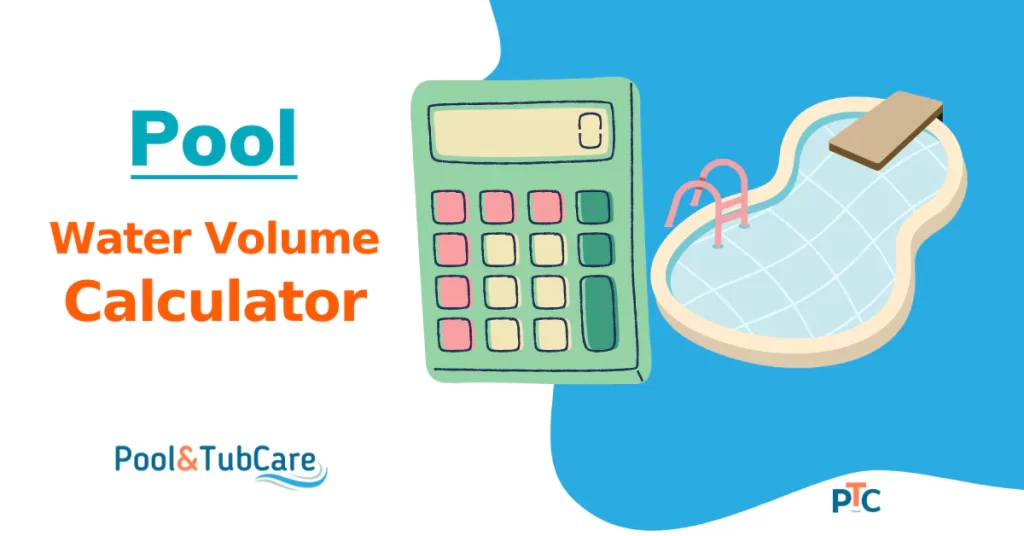Keeping the water clean and safe for swimming is on top of the agenda for all pool owners.
This means maintaining proper pH levels and chlorine levels at all times. It’s easier to do if you have some basic pool chemistry knowledge.
Any swimming pool owner knows that a lot of work goes into keeping a pool clean and safe to swim in.
Several essential tasks must be performed regularly, from skimming the surface to vacuuming the bottom.
The most important of these tasks is maintaining the balance of chemicals. Chemicals kill any unwanted things like bacteria and alage in pool water.
These chemical do their job best when they are in their recommended concentrations.
In this article, I will tell you all the chemicals you will be using and tips to keep your pool running. Always be careful when handling pool chemicals, as they can be dangerous.
Pool Chemistry Ideal Ranges
| Chemical | Ideal Range |
|---|---|
| pH | 7.2 to 7.6 (ideal 7.4) |
| Chlorine levels | 1 to 3 ppm (3 to 5 for commercial pools) |
| Calcium Hardness | 200 to 400 ppm (ideal is ~200) |
| Alkalinity | 80 to 120 ppm |
| Bromine Pools | 3 to 6 ppm Bromine |
| Biguanide Pools | 30 to 50 ppm |
Regular Testing Is Most Important
For a relaxing pool dip, the water should feel clean and refreshing, not slimy or smelly.
Maintaining the proper chemical balance in pool water is essential to achieving this goal, and testing the water regularly so that the water is safe and pleasant to swim in.
Imbalanced pH levels can cause skin irritation, and chlorine levels that are too low can lead to the growth of harmful bacteria.
By testing the water regularly, pool owners can be sure that the levels are within a safe range.
Testing is also important for preventing scale buildup on pool surfaces. If left unchecked, the scale can cause discoloration and make it more difficult to clean the pool.
By keeping a tab on pool chemicals by testing and making adjustments as needed, pool owners can keep their pools looking sparkling clean all season long.
Testing can be done by testing strips or a digital pH tester. pH strips are less accurate but cheap compared to a more accurate pH meter. Buying a digital pH meter for long-term use is a good investment.
Ideal Pool Water Conditions
Your pool water is prone to fluctuations, and it must be taken care of regularly to achieve perfect pool chemistry.
The main things to keep in mind for maintaining perfect pool chemistry include:
- pH levels
- Alkalinity Levels
- Calcium hardness
pH Levels
The proper pH level is essential for keeping the water clean and safe to swim. pH is the indicator of acidity, and on the pH scale, 7 is neutral, below 7 is acidic, and above 7 is basic.
For pool water, the ideal pH range is between 7.2 and 7.6. If the pH level drops below 7.2, the water can become corrosive, damaging the pool’s filter, pump, and other components.
Additionally, low pH levels can irritate swimmers’ skin and eyes.
If the pH level rises above 7.6, the water can become cloudy, and scales can form on surfaces in contact with the water.
Test the pH level regularly and make adjustments as needed to keep it within the ideal range.
Alkalinity levels
Alkalinity is a measure of the water’s ability to neutralize acids, and it helps to maintain a pH balance in the water.
In water with low alkalinity, pH will not stabilize and can lead to eye irritation, skin problems, and other health concerns.
If the alkalinity level goes too high, the water can become cloudy, and scale can build up on surfaces.
Unlike pH, alkalinity is measured in parts per million (ppm), and the ideal range for pool alkalinity is between 80 and 120 ppm.
Calcium hardness
Calcium hardness means the calcium levels in your pool water.
Too much calcium can lead to scaling and cloudy water, while too little can cause corrosion and etching.
Ideally, calcium hardness levels should be between 200 and 400 ppm.
Calcium hardness can be easily adjusted by using soda ash and calcium chloride.
Soda ash raises the water’s pH and adds calcium carbonate, which helps prevent scaling.
Calcium chloride, on the other hand, lowers the water’s pH and adds calcium chloride, which helps prevent corrosion.
Based on the water test results, you can easily decide which chemical needs to be added to maintain the proper calcium hardness levels.
Chemicals to keep Pool Water Clean
Many chemicals are used to keep the water in your pool clean. Some chemicals needs regular addition in your pool like chlorine for sanitization and cyanuric acid to stabilize chlorine.
On the other hand, a few chemicals will be used only in case of a problem.
Like, if you have a pH issue in your pool, you may need to use soda ash or myanuric acid.
In general, it’s a good idea to stock your pool house with various chemicals so that you are prepared to deal with any problem that might arise.
Here are all the chemicals you might need to use:
Chlorine
First, let’s learn about chlorine, as it is the most common chemical disinfectant used to clean pool water.
Free chlorine kills bacteria and other microorganisms that can cause illness. Chlorine also helps to keep the water clear by reducing algal growth.
Now, the question comes up; how much chlorine should you add to your pool?
To answer this question, you’ll need to know the following information:
- The volume of the pool (in gallons)
- Chlorine concentration (in ppm)
- The pH of the pool water
- The alkalinity of the pool water
After getting this information, use a chlorine calculator to determine the amount needed to chlorinate the pool.
Ideally, the chlorine levels should range from 1 ppm to 3 ppm.
Adding chlorine to a pool is a simple process, but it is important to follow directions carefully to avoid over-chlorinating or under-chlorinating the water.
You can buy chlorine from the market, which comes in the form of granules or tablets.
Granules are the quickest way to add chlorine to your pool. Tablets dissolve more slowly but provide a steadier supply of chlorine when used properly.
When adding chlorine to your pool, ensure the pump is running so that the chemical gets evenly distributed throughout the water.
You can also pre-dissolve the chlorine in a bucket of water before adding it to the pool. This will prevent clumping and will ensure the even distribution of chlorine.
Related: Safe chlorine levels for pool water!
Stabilized and Unstabilized Chlorine
Stabilized chlorine, unlike unstabilized chlorine, is less affected by sunlight.
Using stabilized chlorine is a good choice for pools exposed to direct sunlight for long periods.
Stabilized chlorine is more expensive than regular chlorine, but trust me, it’s worth the investment if there are high levels of sunlight in your area.
Cyanuric Acid or Stabilizer
If you are using unstabilized chlorine, you might want to add cyanuric acid as a stabilizer base so that the chlorine doesn’t get burned off by the sun’s UV rays so quickly.
Cyanuric Acid will protect your chlorine from the sun. This way, you can also control the levels of Cyanuric acid in your pool as you add it separately, unlike stabilized chlorine.
Cyanuric Acid Reducer
If you decide to use cyanuric acid, there will be times when its levels are higher than they should be.
Cyanuric acid does not go away on its own. Your best bet to reduce its levels will be by diluting a part of your pool water with fresh water. Still, a Cyanuric acid reducer is always available if water is scarce.
Though a lot of users report that these cyanuric acid chemicals do not work as intended.
Alternative to Chlorine
Anyone who has ever used a chlorinated pool can attest, the strong chemical smell is not pleasant.
In addition, chlorine can also be harsh on the skin and eyes due to chloramines produced upon its breakdown. Chlorine can damage or fade your swimsuits.
You need to replenish chlorine regularly as it gets broken down by the sun regularly. To keep chlorine levels at the required levels, you need regular testing.
For these reasons, people are looking for alternatives to keep their pool water clean.
Bromine
There has been an increasing interest in using bromine as an alternative to chlorine for pool water chemistry.
There are several advantages to using bromine over chlorine, including the fact that bromine is more effective at killing bacteria and viruses, and it is less likely to cause eye and skin irritation.
In addition, bromine is not as easily affected by sunlight, meaning that pool owners will not need to add as much of it regularly. But it still breaks down over time but does not smell as bad as chlorine.
You need to maintain 3 to 6 ppm of bromine for effective cleanliness.
Despite so many advantages, bromine is not yet so popular. Mainly due to its high cost, and it isn’t easy to find in stores.
Overall, whether or not to use bromine in a pool depends on the individual needs and preferences of the pool owner.
Biguanide
One option that is gaining popularity is biguanide.
Biguanide is a type of chemical that is effective at killing bacteria and algae. It does not affect the skin and eyes as chlorine and does not have a strong odor.
It binds the contaminants together, which can be easily caught by a filtering system.
You need 30 to 50 ppm Biguanide for it to be an effective sanitizer.
Again, biguanide can be more expensive than chlorine, and it may not be as effective at killing certain types of bacteria.
Always consider the pros and cons before deciding which type of pool water chemistry is right for you.
Other Chemicals
Here are a few more chemicals you might need to use occasionally.
Algaecides
Algaecides are chemicals that are used to kill algae and prevent it from growing back.
While chlorine (shock) is the most common method of keeping pool water clean, algaecides can be used to supplement chlorine or as a standalone treatment.
Different options of Algaecides are available, some work by damaging the algae’s cell walls, while others work by inhibiting photosynthesis.
Some type of chlorine tablets comes preloaded with algaecides, which can help prevent any algal growth.
Algaecides are safe to use in pools, and they can effectively keep algal growth under check.
Related: How to get rid of algae in a pool?
Flocculant for pool water
Flocculant is a chemical that helps clear pool water by clumping together tiny waste particles, making it easier to remove. It also helps to improve filtration and circulation.
Flocculants also prevent staining and scale buildup on surfaces such as walls and tiles.
Choose a flocculant that is compatible with your pool’s chemistry. Otherwise, you may end up with cloudy water.
Water clarifier for pool water
Water clarifiers remove small particles from the water, which can then be filtered out.
They also improve circulation and prevent the buildup of algae and bacteria.
Water clarifiers are an essential part of the pool maintenance routine.
Some water clarifiers are designed specifically for pool use, and using them will save your pool lining from damage.
Stain and Scale Remover for pool water
You’ll need to use a stain and scale remover if you have a stain or scale problem. This chemical helps prevent stains from forming on pool surfaces and prevents the buildup of scale, making it challenging to keep your pool clean.
To use a stain and scale remover effectively, you must regularly add it to your pool.
Stain and scale removers are acid-based and non-acidic. Acid-based cleaners are more powerful but can also be more corrosive. Non-acidic cleaners are safer but may not be as effective at removing stains and scale.
While using these chemicals, follow the manufacturer’s instructions carefully to avoid damaging your pool. With a bit of elbow grease, your pool will be sparkly clean in no time.
Minerals for pool water chemistry
Maintaining the proper pH and mineral levels in your pool water is essential for preventing algae growth, maintaining water clarity, and protecting swimmers from skin irritation.
Different types of minerals such as calcium, magnesium, and sodium chloride can be used for proper pool water chemistry.
All these minerals provide a few benefits and drawbacks, so choosing the right mix for your pool is important.
Calcium is often used to raise the pH of pool water, as it helps to neutralize acids. However, too much calcium can lead to scale formation on pool surfaces.
Magnesium helps to prevent algae growth and keep the water clear. However, magnesium can also make pool water feel slippery.
Sodium chloride is commonly used to lower the pH of pool water. However, sodium chloride can also increase the likelihood of skin irritation.
When choosing minerals for pool water chemistry, it’s important to strike the right balance to maintain a healthy and safe pool environment.
Shock Your Pool Regularly
One way to keep the water quality high is to shock the pool regularly. This involves adding a large amount of chlorine to the water to kill any bacteria or algae that may be present.
Shocking the pool will also help remove any organic material built up over time.
During peak time, it is advised to shock your pool every week. You can also shock your pool after pool parties as it will eliminate all the contaminants.
Pool shock should be done during the night to be the most effective, as the sun reduces the effectiveness of shock. Add the shock in the evening and run the pump to circulate it through the whole pool water so that every nook and corner of your pool is sanitized.
There are two types of shock: Chlorine and non-chlorine shock. Learn here how to use use them according to your needs.
As the wise say, shock your pool regularly, and you will be safe from most pool problems.
Strike a Balance of Chemicals for a Safe Pool
So the final takeaway is that it is essential to test the water regularly and adjust the chemicals as needed. Be sure to clean the pool regularly, using a brush or vacuum to remove any dirt or debris.
Don’t forget to shock the pool Regularly to keep the water quality high. Knowledge and the appropriate pool chemicals make all the difference.
Following these simple tips, you can enjoy a refreshing and relaxing pool all summer long.

